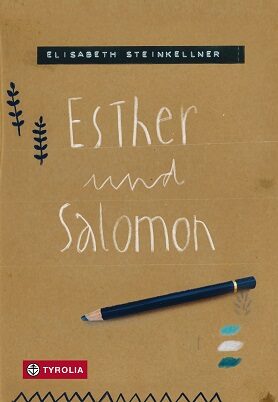Elisabeth SteinkellnerMichael Roher
Esther und Salomon
[Esther and Salomon]
- Tyrolia Verlagsanstalt
- Innsbruck 2021
- ISBN 978-3-70223-917-6
- 336 Pages
- 13 Suitable for age 14 and above
- Publisher’s contact details
Sample translations
When words are not enough
The two little girls become best friends on the spot, and although initially tentative, the relationship between Esther and Salomon soon begins to develop. Esther sneaks out of the hotel at night in order to meet up with Salomon. The sheer delicacy with which Elisabeth Steinkellner evokes the young couple’s initial intimacies bears witness to her absolute mastery of her craft. She is particularly skillful at conveying complex emotions through the subtlety of her word-painting. Following one of her nocturnal forays Esther is rumbled by her parents, and there is an almighty row. But the shared intimacy of love gives people strength, and makes even a girl of fourteen feel indomitable. The holiday is soon going to come to an end, however –
As we read Esther’s narrative we periodically come across polaroid photographs, taken by Elisabeth Steinkellner herself but attributed to Esther. These images of shadows infused with love, of dazzling fireworks, are not in themselves as powerfully expressive as the words they accompany, but they serve to bring out the meanings known or suspected to lurk within the words by playing on the young reader’s own ways of seeing things. At the very end of the novel’s first part, however, there is a highly telling photograph of the two teenagers – revealing for the first time that Salomon’s skin is black.
From this point on it is his voice that recounts the story, and with this we enter a completely new dimension of life. Following his father’s murder in an unnamed African country, Salomon and his mother fled across the Mediterranean in dramatic circumstances and made it to Europe. His mother – previously a schoolteacher – gets a job in a hotel. She becomes involved with another man, and as a result Salomon no longer feels at home even with her. Esther rapidly becomes his emotional sheet anchor – but how is he to tell her that? Again and again the novel poses the question as to how language can find effective expression at the very extremes of human emotion.
Then Salomon’s mother suffers an accident, and uncertainty becomes the predominant theme of the novel. Already moving at speed by this stage, it now gathers even more momentum and develops an intensity that takes the reader’s breath away. Elisabeth Steinkellner’s decision to use prose-poetry for her novel – meaning that there are sometimes only two sentences per page – will no doubt go down well with her young readers: although the book runs to over three hundred pages, the verse form gives the narrative voices of Esther and Salomon a captivating immediacy right from the very first line.
Esther’s Polaroids have their counterpart in Salomon’s sketches, drawn in reality by the illustrator Michael Roher. Delicately shaded in black and white, they depict items such as a teapot and a bunch of flowers. This concentrated focus on everyday objects helpfully enables the reader to draw breath amidst the dramatic onrush of the narrative. The design of the cover and overall layout as well as the choice of typography are equally exquisite. One can only hope that this young-adult novel finds a large readership, dealing as it does with the highly topical subject of migration, combined with the finely drawn emotions of a young couple’s first experience of love.
Translated by John Reddick

By Thomas Linden
Thomas Linden is a journalist (Kölnische Rundschau, WWW.CHOICES.DE) specializing in the areas of literature, theater and film. He also curates exhibitions on photography and picture book illustration.
Publisher's Summary
The passage into adulthood - in all its aspects
Sun, sea, beach - and an explosion of young love: Esther and Salomon, two teenagers, two worlds that at first sight could scarely be more different from each other; yet the pair come together all the same. One of them, Esther, is there on holiday: a keen photographer, she is the child of parents who are steadily drifting apart and no longer have anything to say to one another even in their holiday paradise. The other, Salomon, son of a woman in low-grade employment, is a keen artist, marked by war and migration, and deeply traumatised by his experiences. Each of them carries responsibility for a much younger child - two little girls who find life much easier thanks to their uncomplicated emotions and spontaneous affections, and in consequence offer a blithe, child’s-eye counterpoint to all the weighty cares and worries of the adult world.
The first part of the book, up to the end of her holiday, is recounted by Esther, who uses Polaroid photographs to express her thoughts and feelings. The story is then carried on by means of Salomon’s sketch-book. But does the story in fact carry on? For anxiety intervenes – anxiety triggered by a sudden sense of vulnerability, by the prospect of separation, of being suddenly apart from each other. And dramatic events in the past are brought back to the surface by a terrible accident...
In this book Elisabeth Steinkellner succeeds once again, with fascinating bravura and extraordinary sensitivity for her characters and their situation, in capturing the turbulent process of becoming a adult in all its manifold aspects. She enfolds the entire gamut of different emotions - from radiant happiness through tentative hope to utter despair - within a verse novel additionally enhanced by highly expressive photographs and delicately wrought drawings (by Michael Roher). A powerful, moving and in all respects impressive book.
(Text: Tyrolia Verlagsanstalt)
